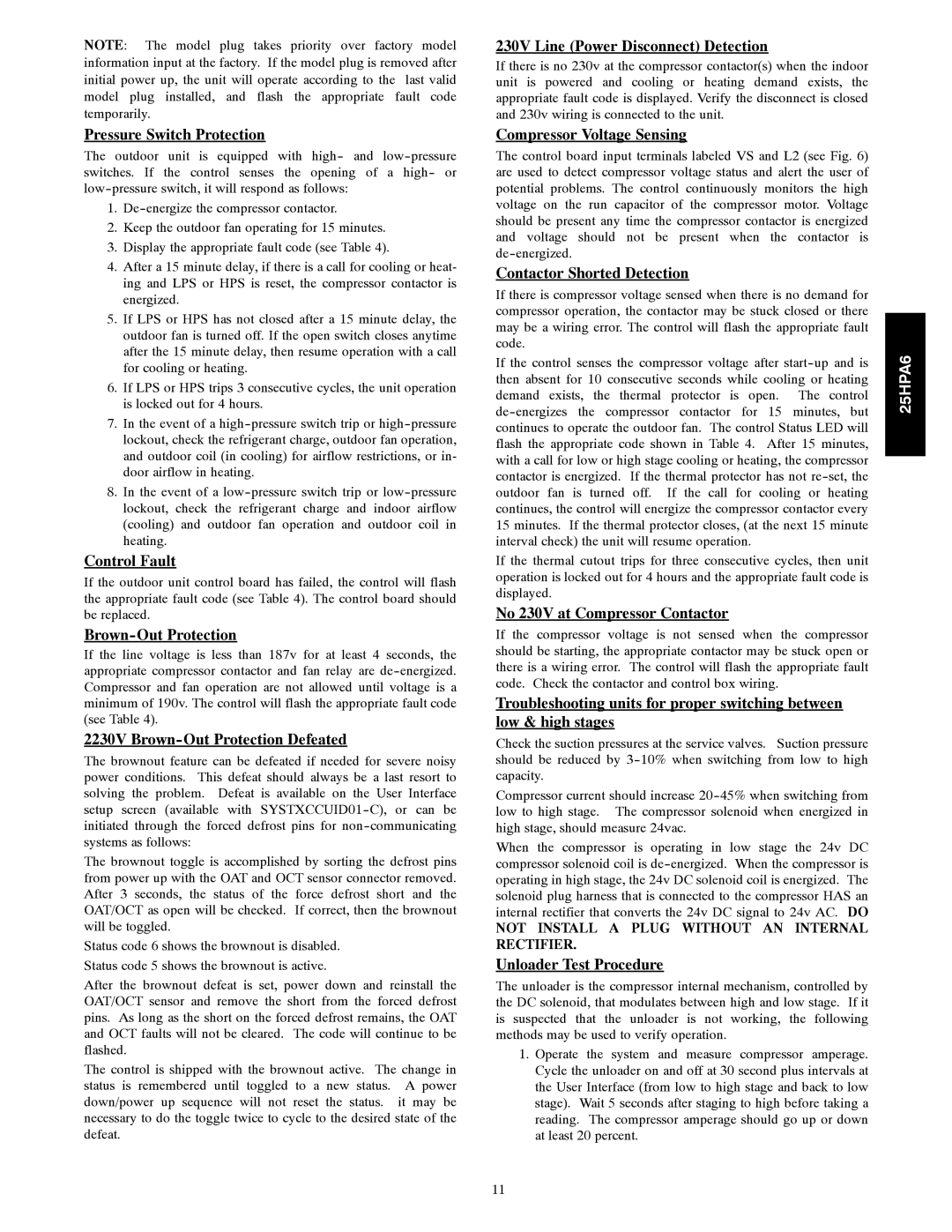
NOTE: The model plug takes priority over factory model information input at the factory. If the model plug is removed after initial power up, the unit will operate according to the last valid model plug installed, and flash the appropriate fault code temporarily.
Pressure Switch Protection
The outdoor unit is equipped with high- and
1.
2.Keep the outdoor fan operating for 15 minutes.
3.Display the appropriate fault code (see Table 4).
4.After a 15 minute delay, if there is a call for cooling or heat- ing and LPS or HPS is reset, the compressor contactor is energized.
5.If LPS or HPS has not closed after a 15 minute delay, the outdoor fan is turned off. If the open switch closes anytime after the 15 minute delay, then resume operation with a call for cooling or heating.
6.If LPS or HPS trips 3 consecutive cycles, the unit operation is locked out for 4 hours.
7.In the event of a
8.In the event of a
Control Fault
If the outdoor unit control board has failed, the control will flash the appropriate fault code (see Table 4). The control board should be replaced.
Brown-Out Protection
If the line voltage is less than 187v for at least 4 seconds, the appropriate compressor contactor and fan relay are
2230V Brown-Out Protection Defeated
The brownout feature can be defeated if needed for severe noisy power conditions. This defeat should always be a last resort to solving the problem. Defeat is available on the User Interface setup screen (available with
The brownout toggle is accomplished by sorting the defrost pins from power up with the OAT and OCT sensor connector removed. After 3 seconds, the status of the force defrost short and the OAT/OCT as open will be checked. If correct, then the brownout will be toggled.
Status code 6 shows the brownout is disabled. Status code 5 shows the brownout is active.
After the brownout defeat is set, power down and reinstall the OAT/OCT sensor and remove the short from the forced defrost pins. As long as the short on the forced defrost remains, the OAT and OCT faults will not be cleared. The code will continue to be flashed.
The control is shipped with the brownout active. The change in status is remembered until toggled to a new status. A power down/power up sequence will not reset the status. it may be necessary to do the toggle twice to cycle to the desired state of the defeat.
230V Line (Power Disconnect) Detection
If there is no 230v at the compressor contactor(s) when the indoor unit is powered and cooling or heating demand exists, the appropriate fault code is displayed. Verify the disconnect is closed and 230v wiring is connected to the unit.
Compressor Voltage Sensing
The control board input terminals labeled VS and L2 (see Fig. 6) are used to detect compressor voltage status and alert the user of potential problems. The control continuously monitors the high voltage on the run capacitor of the compressor motor. Voltage should be present any time the compressor contactor is energized and voltage should not be present when the contactor is
Contactor Shorted Detection
If there is compressor voltage sensed when there is no demand for compressor operation, the contactor may be stuck closed or there may be a wiring error. The control will flash the appropriate fault code.
If the control senses the compressor voltage after
If the thermal cutout trips for three consecutive cycles, then unit operation is locked out for 4 hours and the appropriate fault code is displayed.
No 230V at Compressor Contactor
If the compressor voltage is not sensed when the compressor should be starting, the appropriate contactor may be stuck open or there is a wiring error. The control will flash the appropriate fault code. Check the contactor and control box wiring.
Troubleshooting units for proper switching between low & high stages
Check the suction pressures at the service valves. Suction pressure should be reduced by
Compressor current should increase
When the compressor is operating in low stage the 24v DC compressor solenoid coil is
NOT INSTALL A PLUG WITHOUT AN INTERNAL RECTIFIER.
Unloader Test Procedure
The unloader is the compressor internal mechanism, controlled by the DC solenoid, that modulates between high and low stage. If it is suspected that the unloader is not working, the following methods may be used to verify operation.
1.Operate the system and measure compressor amperage. Cycle the unloader on and off at 30 second plus intervals at the User Interface (from low to high stage and back to low stage). Wait 5 seconds after staging to high before taking a reading. The compressor amperage should go up or down at least 20 percent.
25HPA6
11
